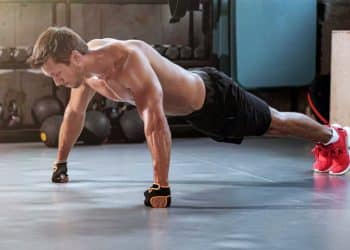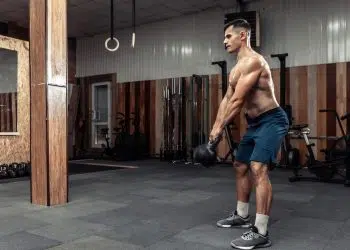With the cost of living going through the roof, finding the discretionary income to pay for a gym membership or costly equipment is a real challenge. Fortunately, the aerobic stepper is an extremely low-cost way to meet your fitness goals. With a stepper and the right routine, you can burn calories by increasing your heart rate and lung capacity. Although aerobic steppers are not as expensive as other cardio options, you can still save some money by making your own.
In this article, I take you through two different DIY aerobic step platform blueprints, single-level and adjustable. We’ll also explore the benefits of aerobic stepping and providing aerobic stepper workouts for novices and advanced trainers.
What is an Aerobic Step Platform?

An aerobic stepper is a fitness equipment designed to improve cardiovascular health, using a form of aerobic training called step aerobics, which involves stepping on and off a small platform. Besides aerobic exercises, you could also use the aerobic step platform for strength training exercises like deficit lunges and glute bridges.
You must build the stepping platform from a non-slip material such as rubber or plastic. While lengths and widths vary, they are typically between 12 and 14 inches wide and 36 inches long.
An aerobic stepper’s changeable height is one of its defining characteristics. Most steppers have risers or blocks underneath the platform that may be added or removed to change the step’s height. This allows users to vary the level of difficulty of their workouts. Lower steps are appropriate for beginners, while higher steps make the exercises more challenging.
Level Up Your Fitness: Join our 💪 strong community in Fitness Volt Newsletter. Get daily inspiration, expert-backed workouts, nutrition tips, the latest in strength sports, and the support you need to reach your goals. Subscribe for free!
When using aerobic steppers, safety is of the utmost importance. The platform has a non-slip surface to keep the user from slipping and avoid injury.
Aerobic steppers are lightweight and transportable, making transferring and storing them easy. Thanks to this portability, they are a practical option for home workouts or group fitness classes.
Aerobic step platforms are used for:
- Step Aerobics: It involves stepping up and down on the platform. It is mainly done for its cardiovascular benefits.
- Strength Training: Aerobic steppers can increase the intensity of exercises such as push-ups, lunges, and the plank.
- Calorie Burn: Steppers are an excellent tool for weight management and fat loss, as aerobic exercises can help burn calories.
2 Ways To Build Your DIY Aerobic Step Platform
Below are two different DIY aerobic stepper blueprints:
Single Height DIY Aerobic Step Platform
This a basic stepper with just one height level. This is the most basic model and can be built by DIY beginners.
Materials:
- Plywood (approximately 12-14 inches wide and 36 inches long)
- Four wooden blocks (4×4 inches each)
- Non-slip surface material (rubber mat, non-slip tape, or adhesive shelf liner)
- Screws
- Screwdriver or drill
- Table saw
- Sandpaper
- Pencil and straightedge
- Paint and paintbrush (optional)
Instructions:
- Measure the stepper’s dimensions on the plywood board and mark them. 12 to 14 inches wide by 36 inches long is standard stepper size.
- Using a table saw, carefully cut encircling the sketched lines.
- Round the edges of the plywood board using sandpaper, a sander, or both.
- Use one of the following techniques to make the plywood board’s top non-slip:
- Adhesive grippy tape: Cut the non-slip material to the plywood’s measurements, then attach it to the top surface evenly and firmly.
- Rubber Matting: Measure the dimensions of a piece of rubber matting, cut it to fit, then attach it to the top surface with screws or adhesive.
- Sand the edges of the four wooden blocks, each measuring 4 by 4 inches.
- Place two wooden blocks on either side of the board’s bottom, an inch from the edges. Make sure they are level and straight, then securely attach them to the underside of the board with screws and a drill or screwdriver.
- Paint the top of the plywood and wooden blocks to add some color and protection.
- Testing: Check how stable your homemade aerobic step platform is by setting it down on a flat surface. The non-slip surface should have stable and effective traction. If necessary, adjust the non-slip material or wooden blocks.
Adjustable Height DIY Aerobic Step Platform
You can turn your single-height stepper into an adjustable version by adding an adjustment mechanism. While it is possible to make such a mechanism, buying three adjustable furniture legs or risers, such as those used for adjustable beds, is much easier. You can get these from most hardware stores.
Here are the extra steps needed to make an adjustable DIY aerobic stepper. These are in addition to the steps already laid out for the single-height aerobic step platform.
Materials for Adjustable Parts:
- Three pairs of adjustable furniture legs or risers (e.g., adjustable bed legs)
- Screws
- Screwdriver or drill
- Measuring tape
- Pencil
Instructions:
Here is the step-by-step process:
Step 1: Preparing the Adjustable Legs:
- Begin by choosing your adjustable furniture legs or risers. These should be designed for easy height adjustment and stability.
- Each pair of adjustable legs typically consists of an outer sleeve and an inner leg with notches or holes to adjust the height.
Step 2: Measuring and Marking:
- Lay your plywood board on a flat surface.
- Use a measuring tape to determine the desired heights for your stepper. Common options are low, medium, and high settings. For example:
- Low: 4 inches
- Medium: 6 inches
- High: 8 inches
- On each adjustable leg, measure and mark the positions that correspond to the desired heights. Ensure that the measurements are accurate and level.
Step 3: Attach the Adjustable Legs:
- Starting with one pair of adjustable legs, align the marked positions on the inner leg with the notches or holes on the outer sleeve.
- Attach the inner leg to the outer sleeve with screws. Do the same for the other two pairs of adjustable legs, setting them at the appropriate height.
Step 4: Add the Adjustable Legs to the Stepper:
Level Up Your Fitness: Join our 💪 strong community in Fitness Volt Newsletter. Get daily inspiration, expert-backed workouts, nutrition tips, the latest in strength sports, and the support you need to reach your goals. Subscribe for free!
- Turn the platform upside down. Place one set of adjustable legs an inch from the outer right edge. Use screws to attach them to the platform.
- Do the same with the other two sets of adjustable legs.
Why Use Different Height Settings on Your Aerobic Stepper
Adjustable aerobic steppers with different height settings provide a variety of advantages, including:
- Progressive Intensity: The primary benefit of adjustable height settings is the opportunity to push your limits progressively. Beginners can begin with shorter step heights and raise them as they gain comfort and self-assurance in their abilities.
- Cardiovascular Conditioning: Aerobic workouts on a stepper can improve your cardiovascular training.
- Energy Burned: Changing the step height can affect the calories burned during a workout. Because raising the legs to a higher position requires more effort, larger step heights increase calorie expenditure.
- Variety in Exercise: Different step heights add variation to your workouts. Users can integrate interval training by alternating between high and low step heights within a single session.
- Balance and Coordination: Changing the height challenges your balance and coordination. Users must concentrate on stability as they advance to higher settings, which can improve their athleticism and motor abilities.
Step Adjustment Tips
Here are some pointers for users who want to advance from one height setting to another on adjustable aerobic steppers:
- Start Slowly: Start with a low setting if you are new to stepper workouts. Increase the height gradually as you build more confidence.
- Monitor Your Form: Pay attention to your form when switching to higher levels. Keep your balance and posture correct to avoid injury.
- Listen To Your Body: Be mindful of any pain or strain. Consider reducing the height until you’re more conditioned if you feel pain or extreme exhaustion.
- Include Variety: Don’t limit yourself to just one height. Switch up the heights to keep your workouts interesting.
Aerobic Stepper Benefits
An aerobic stepper is a low-cost, compact piece of fitness equipment that offers the following benefits:
- Cardio Fitness: Exercising on an aerobic stepper will challenge your cardio system, raising your heart rate and helping your heart pump more blood efficiently. It will also improve your lung capacity. [1]
- Calorie Burn: Working out on an exercise stepper is a good choice for burning calories and managing weight. An average 180-pound person will burn 141 calories for every 15 minutes spent on the aerobic stepper.
- Lower Body Muscle Development: Working out on a stepper stresses the quadriceps, glutes, hamstrings, and calves. Spending a few minutes on the stepper is a great way to finish a leg workout.
- Strength Training: You can use your aerobic stepper for exercises like push-ups and lunges. This makes those exercises more challenging.
- Balance and Coordination: Stepping exercises demand precise movements, which can help you improve your balance and coordination over time. This increase in motor abilities can lead to greater overall athleticism and functional fitness.
- Low-Impact Exercise: Aerobic steppers are an excellent low-impact exercise alternative for persons with joint problems. Less strain is placed on the joints due to the cushioned platform of the stepper.
- Adjustable Intensity: The height of an aerobic step platform can be modified according to your fitness level. Beginners can begin with a lower step height, while advanced users can choose a greater step height to make their workouts more challenging.
- Convenience: Aerobic steppers are portable and small, making them ideal for home workouts. You can stow them in a closet or beneath your bed when not in use. This ease of access promotes consistent activity.
- Low Barrier of Entry: Unlike a treadmill or rowing machine, there isn’t much of a learning curve associated with an aerobic stepper. It is also a very cost-effective cardio training equipment, especially if you make a DIY stepper.
- Enhanced Mood: Aerobic step workouts have been shown to boost mood and lower the risk of depression. A 1997 study published in the Journal of Sports Medicine and Physical Fitness had 42 healthy volunteers do a 50-minute step aerobic workout. Post-working testing showed a significant improvement across the board in vigor, while anger, tension, fatigue, and depression all decreased. [2]
What Is the MET Value of Step Aerobics?
MET values, or Metabolic Equivalent of Task values, are a way to quantify how much energy is used during certain exercises or activities. These values predict how many calories a person will burn while engaging in a particular activity compared to their resting metabolic rate.
MET values help you understand a physical activity’s intensity and energy consumption. The MET value for step aerobics is 6.6. This indicates that when you practice step aerobics, your body burns about 6.6 times as many calories as it does while at rest.
Research and academic studies are used to work out an activity’s MET value. It shows the proportion between the energy used during an activity and the resting energy, which is fixed at 1 MET. Activities with higher MET values indicate a larger energy expenditure.
Here’s a formula to determine how many calories are expended during an activity:
Calories Burned = MET Value x Body Weight in Kilograms x Time in Hours
For a 180-pound (81.65-kilogram) person exercising for 45 minutes (0.75 of an hour), this comes out to be:
6.6 x 81.65 x 0.75 = 404 calories burned
DIY Aerobic Stepper Workout
DIY aerobic exercise stepper workouts can be tailored to various fitness levels and goals.
Beginner Aerobic Workout
Warm Up (5 minutes):
- Minutes 1-4: On the stepper, march while gradually elevating your knees to warm up your lower body.
- Minute 5: Pick up the pace during the final minute.
The Workout (20 minutes):
Spend 2 minutes performing each exercise:
- Step-ups — 2 minutes
- 30-second active rest (marching in place)
- Toe-tapping — 2 minutes
- 30-second active rest (marching in place)
- Side Step-ups — 2 minutes
- 30-second active rest (marching in place)
- Low-Impact March — 2 minutes
- 30-second active rest (marching in place)
- Step-ups — 2 minutes
- 30-second active rest (marching in place)
- Toe-tapping — 2 minutes
- 30-second active rest (marching in place)
- Side Step-ups — 2 minutes
- 30-second active rest (marching in place)
- Low-Impact March — 2 minutes
- 30-Second Break: Breathe deeply and keep yourself hydrated.
Stretching and Cool-Down (5 minutes):
- Minutes 1-2: Walk around.
- Minute 3: While holding onto support, stretch your quads by bending one knee and bringing your heel towards your buttocks.
- Minute 4: Place one foot behind you and plant your heel firmly into the ground to stretch your calf muscles.
- Minute 5: Conclude by softly reaching for your toes to stretch your hamstrings and calves while sitting on the stepper with one leg extended at a time.
Wrap-Up
Beyond only burning calories, using an aerobic stepper has other advantages, such as increased cardiovascular fitness, lower body muscular growth, strength training, improved balance and coordination, low-impact exercise, and customizable intensity.
In this article, we’ve laid out detailed instructions for a single-height and an adjustable-height aerobic stepper for anyone interested in building their own DIY stepper.
An aerobic stepper can help you reach your fitness goals without breaking the bank. Its simplicity, efficiency, and adaptability make it suitable for people of all fitness levels and a worthwhile addition to a home gym.
References
- Nystoriak MA, Bhatnagar A. Cardiovascular Effects and Benefits of Exercise. Front Cardiovasc Med. 2018 Sep 28;5:135. doi: 10.3389/fcvm.2018.00135. PMID: 30324108; PMCID: PMC6172294.
- Kennedy MM, Newton M. Effect of exercise intensity on mood in step aerobics. J Sports Med Phys Fitness. 1997 Sep;37(3):200-4. PMID: 9407751.











